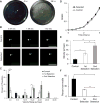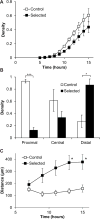Persistent enhancement of bacterial motility increases tumor penetration
- PMID: 25976712
- PMCID: PMC4586311
- DOI: 10.1002/bit.25645
Persistent enhancement of bacterial motility increases tumor penetration
Abstract
Motile bacteria can overcome the transport limitations that hinder many cancer therapies. Active bacteria can penetrate through tissue to deliver treatment to resistant tumor regions. Bacterial therapy has had limited success, however, because this motility is heterogeneous, and within a population many individuals are non-motile. In human trials, heterogeneity led to poor dispersion and incomplete tumor colonization. To address these problems, a swarm-plate selection method was developed to increase swimming velocity. Video microscopy was used to measure the velocity distribution of selected bacteria and a microfluidic tumor-on-a-chip device was used to measure penetration through tumor cell masses. Selection on swarm plates increased average velocity fourfold, from 4.9 to 18.7 μm/s (P < 0.05) and decreased the number of non-motile individuals from 51% to 3% (P < 0.05). The selected phenotype was both robust and stable. Repeating the selection process consistently increased velocity and eliminated non-motile individuals. When selected strains were cryopreserved and subcultured for 30.1 doublings, the high-motility phenotype was preserved. In the microfluidic device, selected Salmonella penetrated deeper into cell masses than unselected controls. By 10 h after inoculation, control bacteria accumulated in the front 30% of cell masses, closest to the flow channel. In contrast, selected Salmonella accumulated in the back 30% of cell masses, farthest from the channel. Selection increased the average penetration distance from 150 to 400 μm (P < 0.05). This technique provides a simple and rapid method to generate high-motility Salmonella that has increased penetration and potential for greater tumor dispersion and clinical efficacy.
Keywords: bacterial cancer therapy; microfluidic tumor-on-a-chip; motility; salmonella; tumor penetration.
© 2015 Wiley Periodicals, Inc.
Figures






References
-
- Forbes NS, Munn LL, Fukumura D, Jain RK. Sparse initial entrapment of systemically injected Salmonella typhimurium leads to heterogeneous accumulation within tumors. Cancer Res. 2003;63(17):5188–93. - PubMed
Publication types
MeSH terms
Grants and funding
LinkOut - more resources
Full Text Sources
Other Literature Sources

